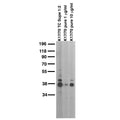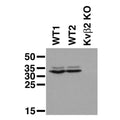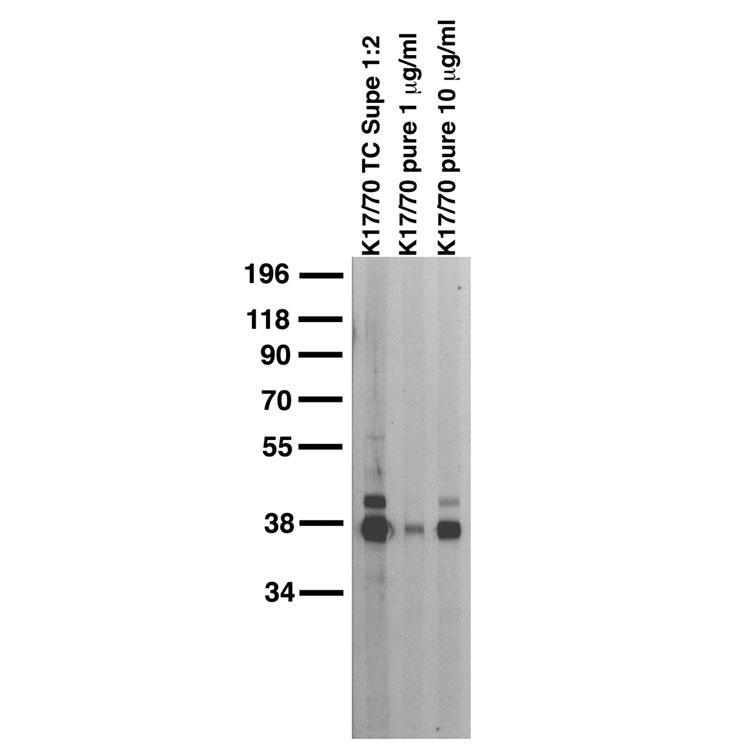Ships: 1-2 business days
Product Specific References for Applications and Species
- Immunocytochemistry: Mouse | Rat
- Immunohistochemistry: Mouse | Rat | Zebra Finch
- Immunoprecipitation: Human | Mouse | Rat
- PLA: Mouse
- Western Blot: Human | Mouse | Non-Human Primate | Rat | Xenopus
| Immunocytochemistry: Mouse | ||
| PMID | Dilution | Publication |
| 18988673 | 1:100 | Ernst, S.J., et al. 2009. Sodium channel beta1 regulatory subunit deficiency reduces pancreatic islet glucose-stimulated insulin and glucagon secretion.. Endocrinology, 1132-9. |
| 17651419 | not listed | Wenzel, H. J., et al. 2007. Structural consequences of Kcna1 gene deletion and transfer in the mouse hippocampus.. Epilepsia, 2023-46. |
| Immunocytochemistry: Rat | ||
| PMID | Dilution | Publication |
| 23318870 | not listed | Ovsepian, S. V., et al. 2013. A defined heteromeric KV1 channel stabilizes the intrinsic pacemaking and regulates the output of deep cerebellar nuclear neurons to thalamic targets.. The Journal of Physiology, 1771-91. |
| 21602278 | not listed | Gu, C., et al. 2011. Clustering and activity tuning of Kv1 channels in myelinated hippocampal axons.. The Journal of Biological Chemistry, 25835-47. |
| 18509034 | not listed | Ogawa, Y., et al. 2008. Postsynaptic density-93 clusters Kv1 channels at axon initial segments independently of Caspr2.. Journal of Neuroscience, 5731-9. |
| Immunohistochemistry: Mouse | ||
| PMID | Dilution | Publication |
| 26269648 | not listed | Kole, M.J., et al. 2015. Selective loss of presynaptic potassium channel clusters at the cerebellar basket cell terminal pinceau in adam11 mutants reveals their role in ephaptic control of purkinje cell firing. . Journal of Neuroscience, 11433-11444. |
| 22560931 | not listed | Jukkola, P. I., et al. 2012. K+ channel alterations in the progression of experimental autoimmune encephalomyelitis.. Neurobiology of Disease, 280-93. |
| 21958379 | not listed | Duflocq, A., et al. 2011. Characterization of the axon initial segment (AIS) of motor neurons and identification of a para-AIS and a juxtapara-AIS, organized by protein 4.1B.. BMC Biology, 6. |
| 20197544 | 1:250 | Stapels, M., et al. 2010. Polycomb group proteins as epigenetic mediators of neuroprotection in ischemic tolerance.. Science Signaling, ra15. |
| Immunohistochemistry: Rat | ||
| PMID | Dilution | Publication |
| 22764231 | not listed | Williams, M. R., et al. 2012. Cellular mechanisms and behavioral consequences of Kv1.2 regulation in the rat cerebellum.. Journal of Neuroscience, 9228-37. |
| 18727953 | not listed | Monaghan, M. M., et al. 2008. Altered expression and localization of hippocampal A-type potassium channel subunits in the pilocarpine-induced model of temporal lobe epilepsy.. Neuroscience, 550-562. |
| Immunohistochemistry: Zebra Finch | ||
| PMID | Dilution | Publication |
| 23818387 | 1:250 | Condro, M. C., et al. 2014. Distribution of language-related Cntnap2 protein in neural circuits critical for vocal learning.. Journal of Comparative Neurology, 169-85. |
| PLA: Mouse | ||
| PMID | Dilution | Publication |
| 31639389 | not listed | Kilfoil, P.J., et al. 2019. Metabolic regulation of Kv channels and cardiac repolarization by Kvβ2 subunits.. Journal of Molecular and Cellular Cardiology, 93-106. |
| Western Blot: Human | ||
| PMID | Dilution | Publication |
| 35396942 | 1:1000 | Roig, S.R., et al. 2022. S-acylation-dependent membrane microdomain localization of the regulatory Kvβ2. 1 subunit. . Cellular and Molecular Life Sciences, 230. |
| Western Blot: Mouse | ||
| PMID | Dilution | Publication |
| 35440632 | 1:400 | Dwenger, M.M., et al. 2022. Pyridine Nucleotide Redox Potential in Coronary Smooth Muscle Couples Myocardial Blood Flow to Cardiac Metabolism. Nature Communications, 2051. |
| 31639389 | 10 µg | Kilfoil, P.J., et al. 2019. Metabolic regulation of Kv channels and cardiac repolarization by Kvβ2 subunits.. Journal of Molecular and Cellular Cardiology, 93-106. |
| 31639389 | 1:100 | Kilfoil, P.J., et al. 2019. Metabolic regulation of Kv channels and cardiac repolarization by Kvβ2 subunits.. Journal of Molecular and Cellular Cardiology, 93-106. |
| 31639389 | 1:100 | Kilfoil, P.J., et al. 2019. Metabolic regulation of Kv channels and cardiac repolarization by Kvβ2 subunits. Journal of molecular and cell cardiology, 93–106. |
| 29476105 | 1:1000 | Nguyen, L.H., et al. 2018. mTOR-dependent alterations of Kv1.1 subunit expression in the neuronal subset-specific Pten knockout mouse model of cortical dysplasia with epilepsy. Scientific Reports, 3568. |
| 26269648 | 1:200 | Kole, M.J., et al. 2015. Selective loss of presynaptic potassium channel clusters at the cerebellar basket cell terminal pinceau in adam11 mutants reveals their role in ephaptic control of purkinje cell firing. . Journal of Neuroscience, 11433-11444. |
| 24036102 | not listed | Bavassano, C., et al. 2013. Identification of voltage-gated K(+) channel beta 2 (Kvβ2) subunit as a novel interaction partner of the pain transducer Transient Receptor Potential Vanilloid 1 channel (TRPV1).. Biochimica et Biophysica Acta, 3166-75. |
| 21507952 | not listed | Cheng, L., et al. 2011. Cortactin is required for N-cadherin regulation of Kv1.5 channel function.. The Journal of Biological Chemistry, 20478-20489. |
| 20685990 | not listed | Ohnishi, H., et al. 2010. Stress-evoked tyrosine phosphorylation of signal regulatory protein α regulates behavioral immobility in the forced swim test.. Journal of Neuroscience, 10472-10483. |
| Western Blot: Non-Human Primate | ||
| PMID | Dilution | Publication |
| 22426702 | not listed | Tipparaju, S. M., et al. 2012. Interactions between the C-terminus of Kv1.5 and Kvβ regulate pyridine nucleotide-dependent changes in channel gating.. Pflügers Archiv: European Journal of Physiology, 799-818. |
| Western Blot: Rat | ||
| PMID | Dilution | Publication |
| 17145502 | not listed | Gu, C., et al. 2006. The microtubule plus-end tracking protein EB1 is required for Kv1 voltage-gated K+ channel axonal targeting.. Neuron, 803-16. |
| Western Blot: Xenopus | ||
| PMID | Dilution | Publication |
| 18684900 | 1:50 | Pineda, R.H, et al. 2008. Kv1 potassium channel complexes in vivo require Kvβ2 subunits in dorsal spinal neurons. . Journal of neurophysiology, 2125-2136. |





